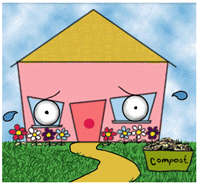It’s spring and the sneezing, red eyes and runny noses are with us as some 20% of Australia’s population succumb to spring fever.
Common allergies
Allergies amount to some of the worst medical problems that we face in Australia. More than one in five people suffer some sort of allergy problem, ranging from weepy eyes and a runny nose to asthma. Rightly or wrongly, many people blame plants for their woes.
But are plants to blame? Often they’re not, or the wrong plant is held to be the culprit. Wattle, for instance, a plant most people believe to be top of the list when it comes to allergies, rarely causes any problems at all.
Allergy plants
The biggest trigger comes from plants most people overlook: the grasses, particularly cool climate grasses. Rye grass and other pasture grasses produce copious quantities of pollen when they flower. This fills the air in spring with just the stuff to cause itchy eyes and sneezing.
Joining the pollen stream are pollens from many deciduous trees. Again, the flowers that produce the pollen are often barely noticed but the pollen is designed to be carried on the wind and, once airborne, it can cause allergies. Ash, oak, liquidambar and plane trees all produce pollen that can trigger hay fever.
Another troublesome but overlooked plant is pellitory, or asthma weed. Very appropriately named, this weed causes distress for many allergy sufferers. Asthma weed grows in cracks in rocks, walls and the pavement thriving in forgotten nooks and crannies. And it frequently flourishes in council-owned land as well as on private property.
Asthma weed, (Parietaria judaica), also known as Pellitory of the wall or sticky weed, has taken hold in areas in and around Sydney, Wollongong and Newcastle. It is also spreading in Perth, Adelaide, Melbourne and Brisbane. It has come into Australia from the Mediterranean region where it is a major problem to control and also a major cause of allergies. It causes allergic reactions through its pollen, which is produced throughout the year but copiously in spring, as well as by coming in contact with its slightly sticky leaves.
Despite its irritant qualities, it is the sort of weed you would walk past and not notice growing in narrow cracks and crevices in walls and pavements. It is extremely difficult to remove by hand as it breaks off, leaving the roots still in place to reshoot. For this reason it is best controlled with a herbicide such as glyphosate (sold as Roundup or Zero). If attempting to hand weed, always wear gloves. In the Sydney metropolitan area local councils are obliged to prevent asthma weed from spreading.
One of the worst trees is the Rhus Tree (Toxicodendron succedaneum) which causes skin allergies in about 98.5% of the population if you have contact with it enough times.
Other triggers
But far outranking the flowering plants, trees and grasses are things inside the house such as dust mites, moulds and animal dander. Moulds can also be found outdoors, for example flourishing in the compost heap. If you know that you are allergic to mould, or prone to bouts of hay fever or asthma, ask someone else in your family to turn the compost heap to avoid unnecessary contact with moulds.
Safe plants
As a rough guide, most brightly flowered plants are either insect or bird pollinated and their pollen doesn’t float about to trigger allergic reactions. On the safe list are most Australian native plants as well as abelia, camellia, azalea, tibouchina, lavender, citrus, impatiens, petunia and pansy.
Plants to avoid
Plants that trigger hay fever include grasses; weeds such as asthma weed, plantain, privet (in flower); conifers including cypress; deciduous trees including oak, liquidambar, maple, ash, birch, plane tree and poplar. There are irritant plants to avoid physical contact with, too. These plants can have prickles or spines, and some even produce sap that is highly irritating to skin and eyes. These plants should also be avoided in a low allergy garden. This group includes Grevillea ‘Robyn Gordon’, silky oak, rhus, chrysanthemums and other daisies, and euphorbias.
Checklist for allergy sufferers
- Talk to your GP or an allergy clinic
- Don’t have a compost heap
- Avoid planting strongly perfumed plants, especially near the windows of the house
- Keep lawns well mown to reduce the amount of flowering and pollen
- Remove weeds, particularly asthma weed, from your garden and lobby your council for its removal in the surrounding area
- Do plant bird pollinated plants (such as callistemons) but avoid plants
- that rely on the wind, such as many deciduous trees.
Further reading
Each state Asthma Foundation produces a free leaflet on The Low Allergen Garden. For further information phone: 1800 645 130 to reach your state organisation.
The Low Allergy Garden by Mark Ragg is a good run-down for allergy sufferers. (Hodder Headline Australia, 1996). Rrp $19.95. ISBN 0733602657.



